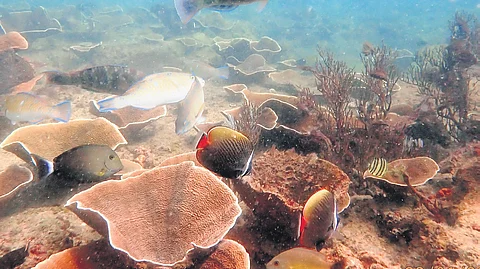

CHENNAI: The Gulf of Mannar on the southeast coast of India is a major reef region with a significant spatial extent of corals. The fringing reefs around the 21 uninhabited islands harbour incredible biodiversity and support the dependent livelihood of fisherfolk. The islands and the surrounding shallow coastal waters were declared the Gulf of Mannar Marine National Park (GOMMNP) by the Tamil Nadu government in 1986.
The beautiful looking coral reefs not only serve as nursing grounds for fishes, but act as natural submerged breakwaters providing coastal protection and flood reduction through wave breaking. According to one estimate, the average annual benefit that one hectare of coral reefs provide is $3.50 lakh, which is 70 times higher than that of tropical forests.
However, over the years due to climate change and anthropogenic stress, a significant part of the live coral cover has been lost. The Inter-Governmental Panel for Climate Change (IPCC) has predicted that global coral reefs would decline by 70-90% with global warming of 1.5°C by 2100 and go extinct, if it is 2°C or higher.
During the recently concluded TN Climate Summit 2.0, a study report titled: ‘Coral reefs of the Gulf of Mannar: Decadal changes in status and management paradigms’ prepared by Thoothukudi-based Suganthi Devadason Marine Research Institute (SDMRI), which is a pioneering institute in coral reefs conservation, was released. It showed that the live coral cover in the region had decline from 37% in 2005 to 27.3% in 2021. Despite signs of gradual recovery, the pace remains sluggish, with the reef area shrinking from 11,060 hectares to 6,628 hectares over the same period. Alarmingly, many former reef sites are now overrun by macroalgae, with 2,631 hectares currently in a degraded state.
Chief drivers
Coral bleaching and ocean acidification due to climate change were primary reasons behind this colossal loss. Annual surveys between 2005 and 2021 show that the coral cover was increasing and reached an all-time high of 42.9% in 2009. The complete halt of coral mining activities after the 2004 Indian Ocean tsunami increased the trend. But there was severe coral bleaching in 2010 due to the second global coral bleaching event, and the consequent coral mortality reduced the average coral cover to 33.2%.
However, the coral cover increased gradually and reached 38.9% in 2015. Severe bleaching due to the third global coral bleaching caused significant mortality in 2016, and the coral cover was reduced to 22.7%. But subsequently it increased to 27.3% in 2021.
The coral mortalities that occurred in 2010 and 2016 impacted all 21 islands. The decline in coral cover was observed in most islands during the study period between 2005 and 2021. Coral cover in 15 of the 21 islands decreased. For instance, Shingle island suffered the most with the loss of 72% of its coral cover followed by Krusadai and Pullivasal islands, which lost more than 55%, as per the SDMRI report.
Going by the climate models, there would be severe coral breaching this year. The US-based National Oceanic and Atmospheric Administration (NOAA) Coral Reef Watch, which is a global early-warning system of environmental changes in coral reef ecosystems, has already issued a red colour-coded alert for the Gulf of Mannar as “above normal” sea surface temperature (SST) is likely to trigger mass bleaching and coral mortality.
Besides this, mechanised trawling, push net operation, shore seine, trap fishing, surface-supplied diving, spear-fishing, purse seine, bottom settling gill nets, ornamental fish collection, and seaweed collection are some fishing activities that damage the fragile reef ecosystems of the Gulf of Mannar. However, the primary threats responsible for the declining trend are coral bleaching events, disease outbreaks, algal blooms and invasion of the exotic red alga, Kappaphycus alvarezii. Most of these natural threats will likely amplify with the deteriorating climate change implications.
Saving sinking islands
The New Indian Express has previously reported how the state forest department successfully saved the sinking Vaan island. The island had split into two due to severe erosion after which artificial reef modules were deployed, which worked like magic. Its acreage improved and now the live cover is an impressive 45.7% from the previous 33.1% in 2005. Now, under the Tamil Nadu Coastal Restoration Mission, which was recently launched by Chief Minister M K Stalin, the forest department plans to replicate its success story at Kariyachalli island, whose land area reduced from 20.85 ha in 2005 to 5.97 ha by 2017, said Supriya Sahu, Additional Chief Secretary, Environments, Climate Change and Forests Department. If there is no intervention, the Kariyachalli island will submerge by 2036.
J K Patterson Edward, director of SDMRI, urged the state government to develop a comprehensive ‘Tamil Nadu Coral Reef Conservation and Management Policy’ aimed to provide highest protection to the sensitive and valuable coral reefs. “Survey, mapping and protection of the reef patches in the deeper waters of Gulf of Mannar outside the marine national park between Rameswaram and Kanniyakumari are needed to sustain coral reefs and to enhance genetic diversity in the face of future climatic conditions.”
Community engagement reduces anthropogenic pressure
Jagdish Bakan, director of the Gulf of Mannar Biosphere Reserve, said to reduce the anthropogenic pressures on the reserve, green jobs are being created by providing concessional micro-credit - a small amount of capital to fund alternative livelihood.
In FY 2022-23, 7,788 women, girls and men were provided micro-credit. Around 55 types of alternative livelihood options were provided to improve their standard of living. Community-based eco-tourism is one of the methods to generate new green jobs. Four new eco-tourism centres were opened and local youth trained and certified to operate facilities like glass bottom boats for coral reef observation, mangrove boating, island boating and dolphin safari etc.
Last year, UNESCO has awarded Bakan the 2023 Michel Batisse Award for Biosphere Reserve Management.